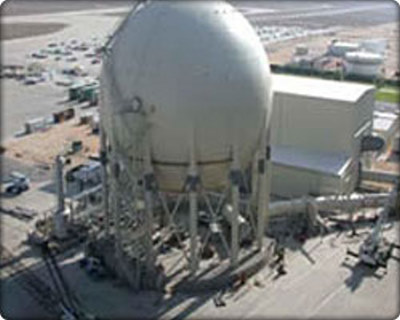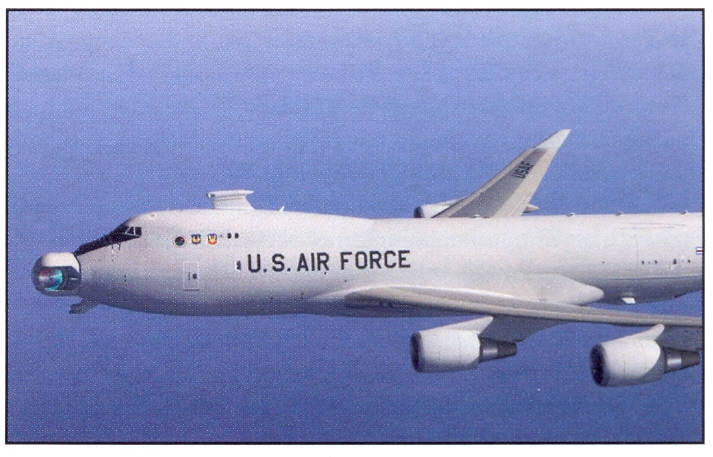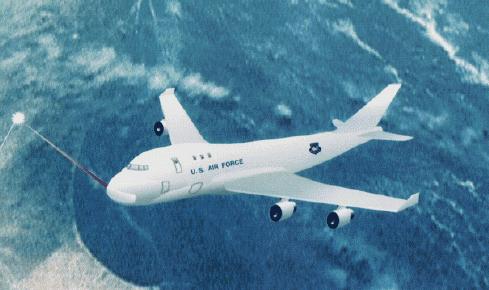|
New Mexico, in southeast Albuquerque |
|||
|
+35° 2' 22.43", -106° 34' 9.76" ...
|
|||
|
....
Airborne Laser (ABL) - News Release
Kirtland Air Force Base in New Mexico may be the home of the Airborne Laser (ABL) -- the place where the first plans for a combat aircraft armed with a high energy laser were drawn up and where many of its scientists, engineers, contract officers, and document producers continue to work -- but all the action is far to the west, at Edwards Air Force Base 100 miles north of Los Angeles on the edge of the baking Mojave Desert. Long recognized as the U.S. Air Force's premier center for testing new aircraft, Edwards is the ideal place to put the ABL through its paces. Also, Edwards is large, relatively flat, and isolated -- a fitting habitat for ABL which requires a lot of space, not only for ABL's 228-foot-long, highly modified Boeing 747-400 Freighter (43 inches longer than the commercial model because of the nose turret), but for a wide array of support facilities. ....
The ITF facility at Edwards is actually a six-building complex dedicated to readying the ABL for its boost-phase role in the United States' multi-layered missile defense system. The ITF will be where the components that make up the weapon system will be ground tested and then assembled on board the ABL aircraft, designated the prototYpe Attack Laser model 1-A (YAL-1A). Although Edwards sprawls over a huge chunk of real estate made remarkable by its large population of Joshua trees, ABL's facilities are concentrated primarily at South Base, behind the towering chain link fences of the Birk Flight Test Facility. Aside from the huge hangar that houses YAL-1A, the ITF's most significant structure may be the 18,000 square-foot System Integration Laboratory (SIL). Inside and sticking out each end of the tin-roofed building is a 747-200 fuselage rescued from an aircraft junkyard. Although a different model from YAL-1A, the interior of the --200 is of almost equal size. This means that ABL's high-energy beam producer -- a Chemical Oxygen Iodine Laser (COIL) -- can be installed and tested there under realistic conditions. ITF facilityIn the spring of 2002, ABL engineers began building the COIL's six modules inside the fuselage. All six will be fired as a unit and tested extensively before they are taken apart and put back together inside YAL-1A. Adjacent to the SIL on the west is a 6,000-square-foot metal-working shop where ABL equipment can be fabricated or repaired. And on the east is the 11-story-tall Ground Pressure Recovery Assembly (GPRA), an airtight, 350,000-cubic foot sphere more than 1½ times the volume of the Goodyear blimp. The GPRA is vital because the high-energy laser was designed to operate in flight where air pressure is much less than on the ground. Because the GPRA simulates the pressure at high-altitude for the laser and collects the laser exhaust, it can operate at ground level. ITF facilityThe only component not within the Birk compound is the Integrated Maintenance Facility (IMF), a two-building unit for storing and mixing the chemicals needed to operate the COIL. Located on the fringe of Rogers Dry Lake bed and a five-minute drive from Birk, the IMF is composed of two buildings totaling 19,000 square feet. One will be used to store the bulk chemicals that make up the ABL-specific compounds; the other will be where the actual mixing takes place.
While YAL-1A and the laser modules were the initial pieces of hardware on site at Edwards, the ABL's intricate optical system will be delivered from the Lockheed Martin facility in Sunnyvale, Calif. Although the optics will be tested in the Lockheed clean room before being disassembled and transported south, they will be ground tested yet again at Edwards once they have been installed in YAL-1A. During the flight test period leading up to ABL's "graduation" exercise -- shooting down a ballistic missile off the California coast -- Edwards will be the base for extensive ground testing that will include all ABL lasers including the Active Ranging System (ARS), the Beacon Illuminator Laser (BILL) and the Target Illuminator Laser (TILL). The powerful COIL will also be fired into a closed test stand during ground tests after being installed on YAL-1A, again with the help of the GPRA. But there will be no open-air testing of the high energy laser. In addition, engineers will use a low-power substitute for the COIL called a Surrogate High Energy Laser (SHEL) for ground and flight tests. |
|||
|
the US Airborne Laser is also closest to deployment
that it is capable of destroying boost-phase ballistic missiles. The world's largest laser, the
US Airborne Laser is also closest to deployment
There are many laser weapon programmers in development worldwide, but the largest and furthest along is the US Missile Defense Agency's Airborne Laser (ABL) programme. The ABL employs hundreds of complicated optics and several lasers to track down and destroy incoming missiles, and it is expected to be deployed by the end of this decade. Much like the first computers, the first laser weapons will extremely large in scale - only time and technology will shrink them. However, the days of laser pistols are still science-fiction. Unlike the ray guns of the movies, these lasers will not even be visible to the naked eye. The ABL, being developed at the Air Force Research Laboratory Directed Energy directorate at Kirtland Air Force Base, N.M., requires a large-scale design to generate enough heat to destroy targets such as missiles. It needs a Boeing 747-400 aircraft to house it. The ABL's purpose is to destroy ballistic missiles during their boost phase, the period when they are moving on a relatively even, predictable path and, because of their pressurised fuel load, are particularly vulnerable to the ABL style of attack. Weather is not a factor because the Airborne Laser aircraft flies above the clouds. SOURCE: Russian News Vimi.ru
Kirtland Air Force Base are exploring different materials to produce efficient lasers ... |
|||
|
Airborne Laser Resources ...
Airborne Laser Resources:
Papers:- [PDF][Archived] - May be some duplicates under other titles
|
|||
| FAIR USE NOTICE: This page contains copyrighted material the use of which has not been specifically authorized by the copyright owner. Pegasus Research Consortium distributes this material without profit to those who have expressed a prior interest in receiving the included information for research and educational purposes. We believe this constitutes a fair use of any such copyrighted material as provided for in 17 U.S.C § 107. If you wish to use copyrighted material from this site for purposes of your own that go beyond fair use, you must obtain permission from the copyright owner. | |||
|
|







